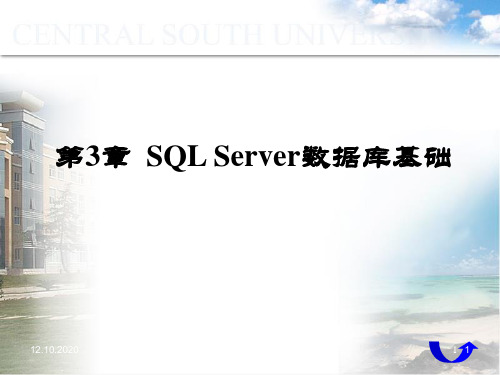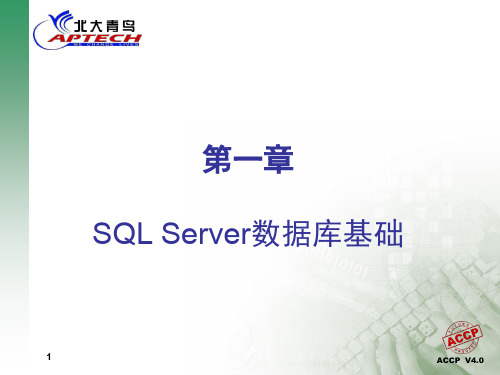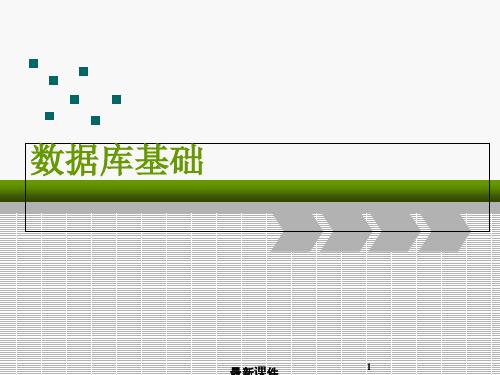SQLServerAnalysis Service学习资料.ppt
合集下载
《sqlserver初级教学资料》第五章上机.ppt

➢ Sql Server中有哪几种系统内置函数? 字符串处理函数 日期时间函数 聚合函数 数学函数
2020/10/9
中国职业教育联盟课程体系
2
上机目标
➢ 将StudentMIS数据库中的数据导到到Excel表格中 ➢ 再将Excel表格中的数据导入到StudentMIS数据库中 ➢ 将StudentMIS数据库用“脚本生成工具”生成为脚本文
2020/10/9
中国职业教育联盟课程体系
5
阶段1
实现效果及关键步骤:
2020/10/9
中国职业教育联盟课程体系
6
阶段2
题目:
将阶段1导出到Excel中的数据重新导入到StudentMIS数据库中
完成时间:15分钟
2020/10/9
中国职业教育联盟课程体系
7
阶段3
使用“数据库脚本生成工具”将StudentMIS数据库生成为SQL 脚本
完成ห้องสมุดไป่ตู้间:25分钟
2020/10/9
中国职业教育联盟课程体系
8
阶段3
实现效果及关键步骤:
2020/10/9
中国职业教育联盟课程体系
9
中国职业教育联盟课程体系 成就百万精英
感谢观映
2020/10/9
中国职业教育联盟课程体系
10
中国职业教育联盟课程体系 成就百万精英
SQLSERVER数据库基础
第五章 数据库管理工具(上机)
2020/10/9
中国职业教育联盟课程体系
1
相关回顾
➢ Select 查询的基本结构是怎样的? Select 列名1, 列名2, …. From 表名 [ where 查询条件 ]
➢ 如何在查询中为列取别名? SELECT scoreId as 课程编号, stuName as 姓名, … SELECT scoreId 课程编号, stuName 姓名, … SELECT 课程编号=scoreId, 姓名=stuName, …
2020/10/9
中国职业教育联盟课程体系
2
上机目标
➢ 将StudentMIS数据库中的数据导到到Excel表格中 ➢ 再将Excel表格中的数据导入到StudentMIS数据库中 ➢ 将StudentMIS数据库用“脚本生成工具”生成为脚本文
2020/10/9
中国职业教育联盟课程体系
5
阶段1
实现效果及关键步骤:
2020/10/9
中国职业教育联盟课程体系
6
阶段2
题目:
将阶段1导出到Excel中的数据重新导入到StudentMIS数据库中
完成时间:15分钟
2020/10/9
中国职业教育联盟课程体系
7
阶段3
使用“数据库脚本生成工具”将StudentMIS数据库生成为SQL 脚本
完成ห้องสมุดไป่ตู้间:25分钟
2020/10/9
中国职业教育联盟课程体系
8
阶段3
实现效果及关键步骤:
2020/10/9
中国职业教育联盟课程体系
9
中国职业教育联盟课程体系 成就百万精英
感谢观映
2020/10/9
中国职业教育联盟课程体系
10
中国职业教育联盟课程体系 成就百万精英
SQLSERVER数据库基础
第五章 数据库管理工具(上机)
2020/10/9
中国职业教育联盟课程体系
1
相关回顾
➢ Select 查询的基本结构是怎样的? Select 列名1, 列名2, …. From 表名 [ where 查询条件 ]
➢ 如何在查询中为列取别名? SELECT scoreId as 课程编号, stuName as 姓名, … SELECT scoreId 课程编号, stuName 姓名, … SELECT 课程编号=scoreId, 姓名=stuName, …
第章SQL-Serve数据库管理ppt课件

Microsoft SQl Server是关系型数据库管理系统。在 关系数据库中,数据库是以关系的方式组织数据的, 关系也就是表。一个数据库可由若干个表组成,通过 一个或多个表中的特定“关系”,相关的数据被有机 地连接起来。用户对数据库的操作实际上就是对表的 操作。 如果使用SQL Server,就可以在单一的数据库文件中 组织、管理所有的信息。在这个文件中,用户可以将 自己的数据分别保存在各自独立的存储单元中,这些 相对独立的存储单元就是表。可以使用联机窗体来查 看、添加并更新表中的数据;使用查询来查找并检索 所需的数据;也可以使用报表以特定的版面布置来分 析及打印数据。数据只需存储一次,就可以在不同的 地方查看。按从大到小的层次,用于SQL Server数据 库系统的信息集合分别是:数据库、表、记录、字段 和值。
精选课件ppt 3
无论在什么情况下,合理的设计都是新建一个能够有效、 准确、及时地完成所需功能数据库的基础。设计数据库 时有许多因素都应考虑,用户要着重考虑以下4方面的 要求: (1)用户需求:从现实世界提取和抽象用户的需求信 息。 (2)概念设计:集成来自不同用户对现实世界的描述 和信息的需求,形成全局概念模式,通常用E-R图表示。 (3)逻辑设计:根据不同的DBMS的特点,把关系数据 库系统从概念模式转化成关系表,并进一步变成规范形 式。 (4)物理设计:为了保证数据库的性能,对库的设计 进行优化,这主要依靠DBMS所提供的手段进行优化构 造。 除此之外,在设计数据库时,还应考虑下列几个问题:
精选课件ppt 5
为了惟一标识实体的每一个实例,每个数据库 表都应当有一个主键,而且只能有一个主键。
一个关系型数据库可能包含多个表,可以通过 外键(Foreign Key)使这些表之间关联起来。 如果在表A中有一个字段对应于表B中的主键, 则该字段称为表A的外键。虽然该字段出现在表 A中,但由它所标识的主体的详细信息却存储在 表B中,对于表A来说这些信息就是存储在表的 外部,因而称之为外键。
精选课件ppt 3
无论在什么情况下,合理的设计都是新建一个能够有效、 准确、及时地完成所需功能数据库的基础。设计数据库 时有许多因素都应考虑,用户要着重考虑以下4方面的 要求: (1)用户需求:从现实世界提取和抽象用户的需求信 息。 (2)概念设计:集成来自不同用户对现实世界的描述 和信息的需求,形成全局概念模式,通常用E-R图表示。 (3)逻辑设计:根据不同的DBMS的特点,把关系数据 库系统从概念模式转化成关系表,并进一步变成规范形 式。 (4)物理设计:为了保证数据库的性能,对库的设计 进行优化,这主要依靠DBMS所提供的手段进行优化构 造。 除此之外,在设计数据库时,还应考虑下列几个问题:
精选课件ppt 5
为了惟一标识实体的每一个实例,每个数据库 表都应当有一个主键,而且只能有一个主键。
一个关系型数据库可能包含多个表,可以通过 外键(Foreign Key)使这些表之间关联起来。 如果在表A中有一个字段对应于表B中的主键, 则该字段称为表A的外键。虽然该字段出现在表 A中,但由它所标识的主体的详细信息却存储在 表B中,对于表A来说这些信息就是存储在表的 外部,因而称之为外键。
sql server课件

设置身份验证模式
选择合适的身份验证模式,如 Windows 身份验证或 SQL Server 身份验证。
打开安装程序
运行安装程序,启动 SQL Server 安装向导。
选择组件和实例
根据实际需求选择要安装的组 件和实例。
配置端口和网络设置
根据实际情况配置 SQL Server 的端口号和网络设置。
配置与优化
权限管理
授予或撤销用户在数据库 中的权限,如SELECT、 INSERT、UPDATE、 DELETE等。
日志管理
日志记录
开启和配置日志记录,记录数据 库的操作和事件。
日志查询
查询和分析日志,了解数据库的使 用情况和潜在的安全风险。
日志归档
定期备份和清理日志,确保日志文 件不会过大。
数据备份与恢复策略
备份策略
制定定期备份计划,选择合适的 备份类型(完全备份、差异备份 、日志备份)和备份介质(硬盘
、磁带、云存储等)。
恢复策略
根据备份情况制定恢复计划,确 保在数据丢失或损坏时能够快速
恢复。
备份与恢复工具
使用SQL Server自带的备份和恢 复工具,或第三方工具进行数据
备份和恢复。
REPORT
THANKS
02
索引可以加快对数据的检索速度,因为它们对数据进行排序并存储指 向数据的指针。
03
索引可以减少数据库查询所需的磁盘I/O操作,从而提高查询性能。
04
索引需要占用额外的磁盘空间,并且可能会降低数据插入、更新和删 除的速度,因为索引结构需要维护。
REPORT
CATALOG
DATE
ANALYSIS
SUMMAR Y
REPORT
第3章SQLServer数据库基础精品PPT课件

10 10
SQL Server 2000的安装
选中“默认”复选框
12.10.2020
11 11
SQL Server 2000的安装
选择身份验证模式
12.10.2020
12 12
SQL Server 2000的安装
2.启动SQL Server 2000的有关组件
12.10.2020
13 13
SQL Server 2000的安装
2. SQL Server中的数据库文件
主仅
文有
一 件一
个 组个
)
数
据
库 的 文 件
次零 文到 件多 组个
(
)
集
(
主数据文件 *.mdf 仅有一个
次数据文件 *.ndf 零到多个
第3章 SQL Server数据库基础
12.10.2020
11
本章内容
3.1 SQL Server简介 3.2 SQL Server数据库概述 3.3 数据库的创建 3.4 数据库的修改 3.5 数据库的删除
12.10.2020
22
3.1 SQL Server简介
SQL Server的发展 SQL Server 是一个关系数据库管理系统。 SQL Server 2000 是Microsoft 公司推出。 SQL Server 2000由两个部分组成:服务器组件和
企业版 Windows 2000 Server 或以上版
Windows NT Server 4.0 或以上版 标准版 Windows 2000 Server 或以上版
个人版 开发版
Windows ME 、Windows 98、Windows NT Workstastion 4.0、 Windows 2000 Professional、Windows XP、 Windows NT Server4.0或 以上版、Windows 2000 Server 或以上版。 Windows NT Workstastion 4.0、Windows 2000 Professional和所有其 他Windows NT 和 Windows 2000 操作系统。
SQLServer数据库基础教材(ppt 32页)

Mary Beth
Alicia Ruth Alicia Ruth Mary Beth
Address
12, Temple Street 123, Sunset Blvd. 32, Golden Avenue
12, Temple Street 12, Tmple Street 33, Golden Avenue
主文件组
26
用户定义文件组
日志文件
ACCP V4.0
创建数据库 3-3
演示创建数据库……
27
ACCP V4.0
管理和维护:收缩数据库
演示收缩数据库……
28
ACCP V4.0
管理和维护:移动数据库
演示分离和附加数据库……
29
ACCP V4.0
管理和维护:配置选项
演示配置数据库的选项……
30
ACCP V4.0
8
ACCP V4.0
数据库的发展史
萌芽阶段——文件系统
使用磁盘文件来存储数据
初级阶段——第一代数据库
出现了网状模型、层次模型的数据库
中级阶段——第二代数据库
关系型数据库和结构化查询语言
高级阶段——新一代数据库
“关系-对象”型数据库
9
ACCP V4.0
时下流行的数据库
Oracle
ACCP V4.0
数据库的基本概念 6-2
行(记录)
列
12
ACCP V4.0
数据库的基本概念 6-3
数据库就是“数据”的“仓库” 数据库由表、关系以及操作对象组成 数据存放在表中
… 订单 客户 产品
表
数据表 存储过程 视图
….
产品数据库
Alicia Ruth Alicia Ruth Mary Beth
Address
12, Temple Street 123, Sunset Blvd. 32, Golden Avenue
12, Temple Street 12, Tmple Street 33, Golden Avenue
主文件组
26
用户定义文件组
日志文件
ACCP V4.0
创建数据库 3-3
演示创建数据库……
27
ACCP V4.0
管理和维护:收缩数据库
演示收缩数据库……
28
ACCP V4.0
管理和维护:移动数据库
演示分离和附加数据库……
29
ACCP V4.0
管理和维护:配置选项
演示配置数据库的选项……
30
ACCP V4.0
8
ACCP V4.0
数据库的发展史
萌芽阶段——文件系统
使用磁盘文件来存储数据
初级阶段——第一代数据库
出现了网状模型、层次模型的数据库
中级阶段——第二代数据库
关系型数据库和结构化查询语言
高级阶段——新一代数据库
“关系-对象”型数据库
9
ACCP V4.0
时下流行的数据库
Oracle
ACCP V4.0
数据库的基本概念 6-2
行(记录)
列
12
ACCP V4.0
数据库的基本概念 6-3
数据库就是“数据”的“仓库” 数据库由表、关系以及操作对象组成 数据存放在表中
… 订单 客户 产品
表
数据表 存储过程 视图
….
产品数据库
SQLServer从零开始学章全套PPT课件

1. SQL Server 2012企业版 2. SQL Server 2012标准版 3. SQL Server 2012商业智能版 4. SQL Server 2012Web版 5. SQL Server 2012开发版
1.5 安装SQL Server 2012
1.5.1 SQL Server 2012 安装环境需求 1.5.2 安装SQL Server 2012 1.5.3 SQL Server 2012 常见实用程序
1.5.1 SQL Server 2012 安装环境需求
1.6 SSMS基本操作
1.6.1 SSMS的启动与连接 1.6.2 使用模板资源管理器、解决方案与项目脚本 1.6.3 配置SQL Server服务器的属性 1.6.4 查询编辑器
第2章 数据库的操作
2.1 数据库组成 2.2 系统数据库 2.3 创建数据库 2.4 管理数据库
作为SQL Server最新的版本,SQL Server 2012具有以下激动人心的 新功能.
1AlwaysOn. 2Columnstore索引. 3DBA自定义服务器权限. 4Windows Server Core支持. 5Sequence Objects. 6PowerView. 7增强的审计功能.
4.4 变量
4.4.1 全局变量 4.4.2 局部变量 4.4.3 批和脚本
4.5 运算符和表达式
4.5.1 算术运算符 4.5.2 比较运算符 4.5.3 逻辑运算符 4.5.4 连接运算符 4.5.5 按位运算符 4.5.6 运算符的优先级 4.5.7 什么是表达式 4.5.8 Transact-SQL表达式的分类
--CREATE TABLE temp -- id INT PRIMAYR KEY, hobby VARCHAR100 NULL
1.5 安装SQL Server 2012
1.5.1 SQL Server 2012 安装环境需求 1.5.2 安装SQL Server 2012 1.5.3 SQL Server 2012 常见实用程序
1.5.1 SQL Server 2012 安装环境需求
1.6 SSMS基本操作
1.6.1 SSMS的启动与连接 1.6.2 使用模板资源管理器、解决方案与项目脚本 1.6.3 配置SQL Server服务器的属性 1.6.4 查询编辑器
第2章 数据库的操作
2.1 数据库组成 2.2 系统数据库 2.3 创建数据库 2.4 管理数据库
作为SQL Server最新的版本,SQL Server 2012具有以下激动人心的 新功能.
1AlwaysOn. 2Columnstore索引. 3DBA自定义服务器权限. 4Windows Server Core支持. 5Sequence Objects. 6PowerView. 7增强的审计功能.
4.4 变量
4.4.1 全局变量 4.4.2 局部变量 4.4.3 批和脚本
4.5 运算符和表达式
4.5.1 算术运算符 4.5.2 比较运算符 4.5.3 逻辑运算符 4.5.4 连接运算符 4.5.5 按位运算符 4.5.6 运算符的优先级 4.5.7 什么是表达式 4.5.8 Transact-SQL表达式的分类
--CREATE TABLE temp -- id INT PRIMAYR KEY, hobby VARCHAR100 NULL
SQLServer从入门到精通第1章数据库基础ppt课件精选全文

Access数据库:其核心是Microsoft Jet数据库引擎。 SQL Server数据库:客户/服务器数据库平台 Oracle数据库:是目前世界上使用最为广泛的关系型数据库。
4
最新课件
初识SQL Server 2008
5
教学目的
通过本章的学习,明白如何安装SQL Server 2008及其帮助, 了解SQL Server 2008集成开发环境启动界面的组成,学会使用 SQL Server 2008 的帮助辅助编程。
sql server
Oracle
杰赛水位在线检测数据库 自控web数据库
奥格水位在线检测数据库 奥格GIS平台数据库
Access
3
最新课件
非关系数据库
关系数据库,是建立在关系数据库模型基础的数据库,通过集合代数等概念和方法来 处理数据库中的数据库。在这里介绍主要介绍Access、SQL Server和Oracle数据库。
36
最新课件
SQL Server的命名规则
SQL Server为了完善数据库的管理机制,设计了严格的命名规则。用户在创建数据库及 数据库对象时必须严格遵守SQL Server的命名规则。 在定义标识符时必须遵守以下规定: (1)标识符的首字符必须是下列字符之一。
统一码(Unicode)2.0标准中所定义的字母,包括拉丁字母a-z和A-Z,以及来自其 他语言的字符。下划线“_”、符号“@”或者数字符号“#”。 (2)标识符的后续字符可以是以下3种。
(1) 更改登录用户验证方式 (2)创建与删除登录名 (3)设置服务器角色权限 (4)创建与删除数据库用户 (5)密码策略
21
最新课件
创建与管理数据库
22
教学目的
4
最新课件
初识SQL Server 2008
5
教学目的
通过本章的学习,明白如何安装SQL Server 2008及其帮助, 了解SQL Server 2008集成开发环境启动界面的组成,学会使用 SQL Server 2008 的帮助辅助编程。
sql server
Oracle
杰赛水位在线检测数据库 自控web数据库
奥格水位在线检测数据库 奥格GIS平台数据库
Access
3
最新课件
非关系数据库
关系数据库,是建立在关系数据库模型基础的数据库,通过集合代数等概念和方法来 处理数据库中的数据库。在这里介绍主要介绍Access、SQL Server和Oracle数据库。
36
最新课件
SQL Server的命名规则
SQL Server为了完善数据库的管理机制,设计了严格的命名规则。用户在创建数据库及 数据库对象时必须严格遵守SQL Server的命名规则。 在定义标识符时必须遵守以下规定: (1)标识符的首字符必须是下列字符之一。
统一码(Unicode)2.0标准中所定义的字母,包括拉丁字母a-z和A-Z,以及来自其 他语言的字符。下划线“_”、符号“@”或者数字符号“#”。 (2)标识符的后续字符可以是以下3种。
(1) 更改登录用户验证方式 (2)创建与删除登录名 (3)设置服务器角色权限 (4)创建与删除数据库用户 (5)密码策略
21
最新课件
创建与管理数据库
22
教学目的
SQL-Server数据库及应用课件汇总全套ppt完整版课件最全教学教程整套课件全书电子教案

▪ 用户级对应外模式,概念级对应模式,物理 级对应内模式,使不同级别的用户对数据库 形成不同的视图。
1.1.4 数据库系统的体系结构
▪ 1.数据库的三级模式结构
▪ (1)模式 ▪ 模式又称概念模式或逻辑模式,对应于概念级。 ▪ 是对数据库中全部数据的逻辑结构和特征的总体描
述,是所有用户的公共数据视图(全局视图)。 ▪ 由数据库管理系统提供的数据模式描述语言(Data
Description Language,DDL)来描述、定义的 ,体现、反映了数据库系统的整体观。
1.1.4 数据库系统的体系结构
▪ 1.数据库的三级模式结构
▪ (2)外模式 ▪ 外模式又称子模式,对应于用户级。它是某个或某
几个用户所看到的数据库的数据视图,是与某一应 用有关的数据的逻辑表示。
▪ 外模式是从模式导出的一个子集,包含模式中允许 特定用户使用的那部分数据。用户可以通过外模式 描述语言来描述、定义对应于用户的数据记录(外 模式),也可以利用数据操纵语言对这些数据记录 进行操作。外模式反映了数据库的用户观。
1.1.3 数据模型
▪ 2.数据模型的组成要素
▪ (3)数据约束
数据模型中的数据约束主要描数据结构内数 据间的语法、词义联系、它们之间的制约和依 存关系,以及数据动态变化的规则,以保证数 据的正确、有效和相容。
1.1.3 数据模型
▪ 3.概念模型 ▪ 概念模型是按用户的观点对数据和信息
进行抽象。 ▪ “实体联系方法”是表示概念模型最常
联系。这种模型描述数据的组织形式像一棵倒置的 树,它由节点和连线组成,其中节点表示实体。根 节点只有一个,向下分支,是一种一对多的关系。 ▪ 层次模型的查询效率很高,但它只能表示一对多联 系,对数据进行查询和更新操作时则很复杂,所以 编写应用程序也很复杂。
1.1.4 数据库系统的体系结构
▪ 1.数据库的三级模式结构
▪ (1)模式 ▪ 模式又称概念模式或逻辑模式,对应于概念级。 ▪ 是对数据库中全部数据的逻辑结构和特征的总体描
述,是所有用户的公共数据视图(全局视图)。 ▪ 由数据库管理系统提供的数据模式描述语言(Data
Description Language,DDL)来描述、定义的 ,体现、反映了数据库系统的整体观。
1.1.4 数据库系统的体系结构
▪ 1.数据库的三级模式结构
▪ (2)外模式 ▪ 外模式又称子模式,对应于用户级。它是某个或某
几个用户所看到的数据库的数据视图,是与某一应 用有关的数据的逻辑表示。
▪ 外模式是从模式导出的一个子集,包含模式中允许 特定用户使用的那部分数据。用户可以通过外模式 描述语言来描述、定义对应于用户的数据记录(外 模式),也可以利用数据操纵语言对这些数据记录 进行操作。外模式反映了数据库的用户观。
1.1.3 数据模型
▪ 2.数据模型的组成要素
▪ (3)数据约束
数据模型中的数据约束主要描数据结构内数 据间的语法、词义联系、它们之间的制约和依 存关系,以及数据动态变化的规则,以保证数 据的正确、有效和相容。
1.1.3 数据模型
▪ 3.概念模型 ▪ 概念模型是按用户的观点对数据和信息
进行抽象。 ▪ “实体联系方法”是表示概念模型最常
联系。这种模型描述数据的组织形式像一棵倒置的 树,它由节点和连线组成,其中节点表示实体。根 节点只有一个,向下分支,是一种一对多的关系。 ▪ 层次模型的查询效率很高,但它只能表示一对多联 系,对数据进行查询和更新操作时则很复杂,所以 编写应用程序也很复杂。
《SQLServer教程》课件

SQL Server的配置与管理
01
02
03
04
05
配置SQL Serve…
配置网络连接
数据库管理
安全性管理
性能监控和维护
设置SQL Server服务的启 动模式、账户和权限等。
配置SQL Server的网络协 议、端口和防火墙设置, 以便客户端能够连接到数 据库。
创建、修改和删除数据库 ,以及管理数据库中的对 象和数据。
SQL Server的安全实践
定期更新补丁和安全加固
及时更新SQL Server的补丁和安全加 固措施,修复已知的安全漏洞。
限制网络访问
限制SQL Server的网络访问范围,只 允许必要的IP地址和服务进行连接。
使用强密码策略
强制要求用户使用复杂、不易猜测的 密码,并定期更换密码。
备份和恢复
定期备份数据库,并制定详细的备份 和恢复计划,以应对安全事件和数据 丢失的情况。
或T-SQL语句来查看、修改和删
除触发器。
存储过程与触发器的应用场景
数据验证
使用存储过程对输入数据进行验证, 确保数据的准确性和完整性。
业务逻辑处理
通过触发器在数据修改时自动执行特 定的业务逻辑,如自动记录日志或更 新统计信息。
批量数据处理
使用存储过程批量处理数据,提高数 据处理效率。
安全性控制
通过触发器实现安全性控制,如限制 对敏感表的访问或阻止非法操作。
THANKS
感谢观看
SQL Server的特点与优势
SQL Server提供了直观的用户界 面和丰富的文档资源,使得用户 可以快速上手并高效地管理数据 库。
SQL Server具备强大的数据处理 和查询性能,支持大规模数据存 储和处理。
《SQLServer数据库》课件

进行数据库实例配置,设置数据库引擎、身份验证和其他相关参数。
3
数据库创建和管理
学习如何创建数据库和管理数据库对象,包括表、视图、索引、存储过程和触发 器。
数据库的基本操作
数据库表的 创建和管理
学习如何创建表结 构,定义列和约束, 并进行表数据的增 删改查操作。
数据库视图 的创建和管 理
了解视图的概念和 用途,学习创建视 图和在视图上进行 数据查询和更新操 作。
《SQLServer数据库》PPT 课件
学习SQLServer数据库的课程PPT,带您深入了解数据库的特点和优势,学 会安装配置和基本操作,掌握SQL语言的基本操作和数据库备份恢复技巧, 以及数据库性能优化和应用场景。
SQLServer数据库简介
什么是SQLServer数据库?
SQLServer数据库是由微软开发的关系型数 据库管理系统,用于存储、管理和操作大量 数据。
数据库性能优化的工具和技巧
了解常用的数据库性能优化工具,掌握性能监控和调优的技巧。
SQLServer数据库的应用
SQLServer数据库在企业中的应 用
了解SQLServer数据库在企业级应用系统中的 使用场景和案例,如ERP、CRM和大数据分析。
SQLServer数据库在互联网中的 应用
学习SQLServer数据库在互联网产品和服务中 的应用,如电商平台、社交媒体和在线游戏。
数据库索引 的创建和管 理
掌握索引的作用和 种类,学习如何创 建索引以提高查询 性能。
数据库存储 过程和触发 器介绍
介绍存储过程和触 发器的概念和使用 方法,以及它们在 数据库业务逻辑中 的应用。
SQL语言的基本操作
1
SQL语言的基本语法
数据库SQLSEVER学习PPT

要点三
示例
创建一个名为"Employees"的数据表 ,包含"EmployeeID"、"FirstName" 、"LastName"、"Email"和 "PhoneNumber"等列。
修改数据表结构
总结词
掌握如何修改已存在的数据表结构,包括添加、删除和修 改列,以及修改列的数据类型和约束条件。
详细描述
03
SQL Server Configuration Manager:用于配置和管理 SQL Server服务、协议和实例 的工具。
SQL Server的数据类型
数值类型 字符类型 日期和时间类型 其他数据类型
包括整数类型(如int、bigint)、小数类型(如decimal、 numeric)、货币类型(如money、smallmoney)等。
角色管理
02
03
访问控制列表
通过创建数据库角色,将具有相 似权限的用户归类到同一角色中, 方便权限管理。
设置访问控制列表,限制对数据 库的访问,防止未经授权的用户 访问数据库。
数据库备份与恢复
备份策略
制定合适的备份策略,定期对数据库进行备份,确保 数据安全。
恢复模式
根据需求选择适当的恢复模式,以便在数据丢失时能 够快速恢复。
索引优化
01
合理使用索引,提高查询速度和数据检索效率。
查询优化
02
编写高效、简洁的SQL查询语句,减少不必要的计算和资源消
耗。
数据库维护
03
定期进行数据库维护,如更新统计信息、重建索引等,以保持
数据库性能。
06
- 1、下载文档前请自行甄别文档内容的完整性,平台不提供额外的编辑、内容补充、找答案等附加服务。
- 2、"仅部分预览"的文档,不可在线预览部分如存在完整性等问题,可反馈申请退款(可完整预览的文档不适用该条件!)。
- 3、如文档侵犯您的权益,请联系客服反馈,我们会尽快为您处理(人工客服工作时间:9:00-18:30)。
Subject-Oriented
• Subject-Oriented data is organized around major subject areas of an enterprise and is useful for an enterprise-wide understanding of those subjects. For Example, a banking operational system maintains independent records of customer savings, loans, and other transactions. A warehouse pulls this independent data together to provide financial information. The data from diverse sources is transformed so that it is consistent and meaningful for the warehouse. So the main work is around the fact table.
Recommend:
1 is very clear and understandable 2 can utilize fully the index of database linked. It is more efficient than 1. So Dimension table can adopt 1 Original table can adopt 2
– DTS design and schedule – The dimension data is incremental, it is to say that they can be inserted and updated, but can’t be deleted. And dimension data must be unique. – The original or fact data is incremental, but according to requirement, it can be updated or deleted under the control. The full process is danger and impossible when the data volume is too huge.
history and temporary table
The large-volume table can be divided into:
– Temporary table – History table It may be inconvenient. But it can improve the performance, temporary table is used to make fact table quickly. Temporary data should be transfer into history table periodically.
– – – – – – Original data from data source Dimension Measurement dimension granularity Star model or snowflake model OLAP model
• •
Integrated
• • Data on a given subject is integrated. In many organizations, data resides in diverse independent systems, making it difficult to integrate the information into a single set of meaningful data from analysis. A key characteristic of a warehouse is that data is completely consolidated or integrated. Data is structured in a globally accepted manner, even when the underlying source data is structured differently (conforming dimension). Integration and transformation processes can be time-consuming and costly. It requires commitment from every part of the organization, particularly top-level managers who make the decisions and allocate resources and funds. So the main work may be like :
SQL Server 2000 Analysis Service
Agenda
• Data Warehouse Concept • Database Design (Physics and Logic) • Backup
Data Warehouse Concept
A data warehouse is a subject-oriented, integrated, nonvolatile, time-variant collection of data designed to support management DSS needs.
• • • •
Database Design
• • • • • • • Database design File Group design History and temporary table design No Partition but view Database link Log table Increment ETL
– Classify by Business – Classify by process – Classify by data (history and temporary) Recommend by process – Bidw_org original data storage – Bidw_fact fact data storage – Bidw_dim dimension data storage
• • •
Time-Variant
• Warehouse data is by nature historical; data is retained for a long time, from two to ten years, compared with one to three months of data for a typical operational system. The data allows for analysis of past and present trends, and for forecasting, using what-if scenarios. Base the Time-Variant and data volume, we must consider : The design about the database The design about the table The OLAP increment
No Partition but View
It is still the performance bottleneck of SQL Server.
– SQL Server 2000 not support the partition – SQL Server 2000 encounter bottleneck when the data volume is more than 10,000,000. – But It support view union. – The large-volume table can be divide into different table like tablename_yyyymm, then create a view to union them. Like create view v_fact_table as select * from t_fact_table_200601 union all select * from t_fact_table_200602 union all select * from t_fact_table_200603
– – – – Universal dimension from different department. Dimension design include NULL value or violate constraint Define mid-exchange table But we didn’t control the data quality caused by man-made
•
Nonvolatile
• Typically, data in the data warehouse is read-only (less volatile than operational systems). Data is loaded into the data warehouse for the first-time load, and then refreshed regularly. Warehouse data is accessed by business users. Warehouse operations typically involve: Loading the initial set of warehouse data (often called the first-time load) Refreshing the data regularly (called the refresh cycle) So the main work is around:
